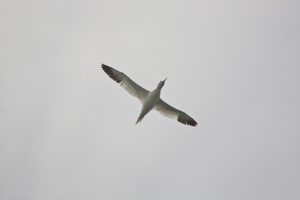Skelligs Birds
There are many species of Skelligs Birds, some use the Skellig islands as a stop off point on their way to other destinations, while other Skelligs Birds return to the islands year on year to breed, the most commonly found birds on the skellig islands are listed below.
The Gannet of Skellig Michael
The Gannet,scientific name the Morus. The Gannets are black and white in colour with yellow heads and long pointed wings and long bills.The gannet is Ireland’s largest sea bird with a wing span of two metres.The small Skellig is the home to some 27,000 pairs of these beautiful birds.This huge number makes the small skelligs the second largest colony of Gannets in the world. They are strong and streamed line and are therefore able to plunge to the sea at break neck speed to catch their prey.
The Puffin of Skellig Michael
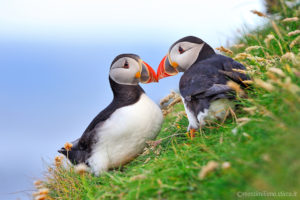 The Puffins scientific name: Fratercula arctica. They are also known as the “clowns of the sea” or “sea parrots”. The Puffin is colourful and playful character and has the most beautiful markings. The puffin has black back and white underparts, and distinctive black head with large pale cheeks and a tall, flattened, brightly-coloured bill. Its comical appearance is heightened by its red and black eye-markings and bright orange legs. This makes the Puffin one of the most instantaneously recognisable birds and one of the world’s favourites.
The Puffins scientific name: Fratercula arctica. They are also known as the “clowns of the sea” or “sea parrots”. The Puffin is colourful and playful character and has the most beautiful markings. The puffin has black back and white underparts, and distinctive black head with large pale cheeks and a tall, flattened, brightly-coloured bill. Its comical appearance is heightened by its red and black eye-markings and bright orange legs. This makes the Puffin one of the most instantaneously recognisable birds and one of the world’s favourites.
The Arctic Tern of Skellig Michael
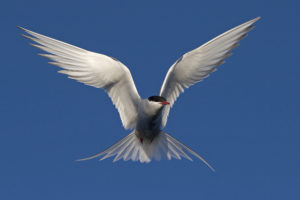 The Arctic Tern, scientific name Sterna paradisaea. Arctic Terns are long-lived birds, with many reaching thirty years of age. They eat mainly fish and small marine invertebrates.The Arctic Tern is medium-sized bird approximately 33–36 cm (13–15 in) from the tip of its beak to the tip of its tail. The wingspan is 76–85 cm; weight is 86–127 g (3.0–4.5 oz). The beak is dark red, as are the short legs and webbed feet.Like most terns, the Arctic Tern has high aspect ratio wings and a tail with a deep fork. The adult plumage is grey above, with a black nape and crown and white cheeks.
The Arctic Tern, scientific name Sterna paradisaea. Arctic Terns are long-lived birds, with many reaching thirty years of age. They eat mainly fish and small marine invertebrates.The Arctic Tern is medium-sized bird approximately 33–36 cm (13–15 in) from the tip of its beak to the tip of its tail. The wingspan is 76–85 cm; weight is 86–127 g (3.0–4.5 oz). The beak is dark red, as are the short legs and webbed feet.Like most terns, the Arctic Tern has high aspect ratio wings and a tail with a deep fork. The adult plumage is grey above, with a black nape and crown and white cheeks.
Black Guillemot of Skellig Michael
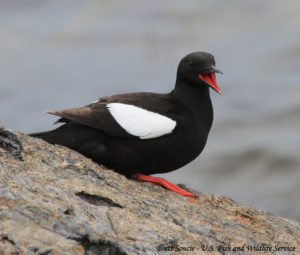 The Black Guillemot or Tystie, scientific name Cepphus grille. It is medium-sized at 32-38 cm in length, and with a 49-58 cm wingspan. Adult birds have black bodies with a white wing patch, a thin dark bill and red legs and feet.They show white wing linings in flight. In winter, the upperparts are pale grey and the underparts are white. The wings remain black with the large white patch on the inner wing.Its striking black and white plumage and bright red feet make it easy to identify in summer. The black guillemot is typically found in ones and twos, scattered around rocky islets.
The Black Guillemot or Tystie, scientific name Cepphus grille. It is medium-sized at 32-38 cm in length, and with a 49-58 cm wingspan. Adult birds have black bodies with a white wing patch, a thin dark bill and red legs and feet.They show white wing linings in flight. In winter, the upperparts are pale grey and the underparts are white. The wings remain black with the large white patch on the inner wing.Its striking black and white plumage and bright red feet make it easy to identify in summer. The black guillemot is typically found in ones and twos, scattered around rocky islets.
Herring Gull of Skellig Michael
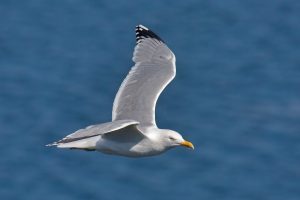 The Herring Gull, scientific name Larus argentatus. The Herring Gull Adults have light grey backs, white under parts, and black wing tips with white ‘mirrors’. Their legs are pink, with webbed feet and they have heavy, slightly hooked bills marked with a red spot. Young birds are mottled brown.
The Herring Gull, scientific name Larus argentatus. The Herring Gull Adults have light grey backs, white under parts, and black wing tips with white ‘mirrors’. Their legs are pink, with webbed feet and they have heavy, slightly hooked bills marked with a red spot. Young birds are mottled brown.
The Razorbill of Skellig Michael
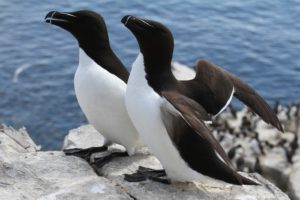 The Razorbill, scientific name Alca torda. The adult birds are black on their upperparts and white on the breast and belly. The thick black bill has a blunt end. The tail is pointed and longer than that of a Murre. In winter, the black face becomes white. There are a pretty large auk 38-43 cm in length, with a 60-69 cm wingspan.
The Razorbill, scientific name Alca torda. The adult birds are black on their upperparts and white on the breast and belly. The thick black bill has a blunt end. The tail is pointed and longer than that of a Murre. In winter, the black face becomes white. There are a pretty large auk 38-43 cm in length, with a 60-69 cm wingspan.
The Fulmar of Skellig Michael
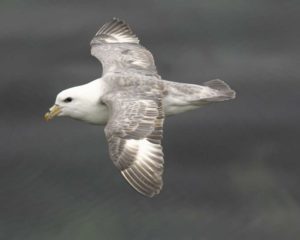 The Fulmar,scientific name Fulmarus glacialis. The Fulmar look superficially like gulls, but are unrelated, and are in fact petrels. The northern species is grey and white with a yellow bill, 43–52 cm (17–20 in) in length with a 102–112 cm (40–44 in) wingspan. In winter the Fulmars disperse over the sea often following fishing boats from discarded fish scraps. Intruders to the nest are attacked with vile-smelling oil which the Fulmers spit at them. The birds may also spend hours gliding past a possible nesting ledge trying to land on it, only to be repelled by other birds.
The Fulmar,scientific name Fulmarus glacialis. The Fulmar look superficially like gulls, but are unrelated, and are in fact petrels. The northern species is grey and white with a yellow bill, 43–52 cm (17–20 in) in length with a 102–112 cm (40–44 in) wingspan. In winter the Fulmars disperse over the sea often following fishing boats from discarded fish scraps. Intruders to the nest are attacked with vile-smelling oil which the Fulmers spit at them. The birds may also spend hours gliding past a possible nesting ledge trying to land on it, only to be repelled by other birds.
The Manx Shearwater of Skellig Michael
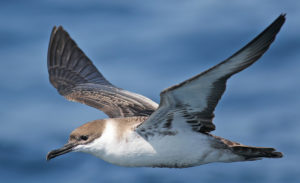 The Manx Shearwater, scientific name Puffinus puffinus. This bird is 30–38 cm long, with a 76–89 cm wingspan. It has the typically “shearing” flight of the genus, dipping from side to side on stiff wings with few wingbeats, the wingtips almost touching the water. This bird looks like a flying cross, with its wing held at right angles to the body, and it changes from black to white as the black upperparts and white undersides are alternately exposed as it travels low over the sea. The Manx Shearwater feeds on small fish (particularly herring, sprat and sardines), crustaceans, cephalopods and surface offal. The bird forages individually or in small flocks, and it makes use of feeding marine mammals and schools of predatory fish, which push prey species up to the surface. It does not follow boats.
The Manx Shearwater, scientific name Puffinus puffinus. This bird is 30–38 cm long, with a 76–89 cm wingspan. It has the typically “shearing” flight of the genus, dipping from side to side on stiff wings with few wingbeats, the wingtips almost touching the water. This bird looks like a flying cross, with its wing held at right angles to the body, and it changes from black to white as the black upperparts and white undersides are alternately exposed as it travels low over the sea. The Manx Shearwater feeds on small fish (particularly herring, sprat and sardines), crustaceans, cephalopods and surface offal. The bird forages individually or in small flocks, and it makes use of feeding marine mammals and schools of predatory fish, which push prey species up to the surface. It does not follow boats.
The Cormorant of Skellig Michael
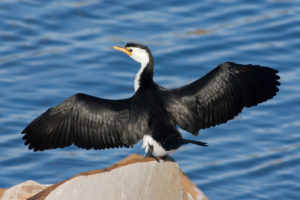 The Cormorant, scientific name Phalacrocoracidae. The bird family Phalacrocoracidae or the cormorants is represented by some 40 species of cormorants and shags. Several different classifications of the family have been proposed recently, and the number of genera is disputed. They range in size from the Pygmy Cormorant (Phalacrocorax pygmaeus), at as little as 45 cm (18 in) and 340 g (12 oz), to the Flightless Cormorant (Phalacrocorax harrisi), at a maximum size 100 cm (40 in) and 5 kg (11 lb). Many species have areas of coloured skin on the face (the lores and the gular skin) which can be bright blue, orange, red or yellow, typically becoming more brightly coloured in the breeding season. The bill is long, thin, and sharply hooked. Their feet have webbing between all four toes, as in their relatives.
The Cormorant, scientific name Phalacrocoracidae. The bird family Phalacrocoracidae or the cormorants is represented by some 40 species of cormorants and shags. Several different classifications of the family have been proposed recently, and the number of genera is disputed. They range in size from the Pygmy Cormorant (Phalacrocorax pygmaeus), at as little as 45 cm (18 in) and 340 g (12 oz), to the Flightless Cormorant (Phalacrocorax harrisi), at a maximum size 100 cm (40 in) and 5 kg (11 lb). Many species have areas of coloured skin on the face (the lores and the gular skin) which can be bright blue, orange, red or yellow, typically becoming more brightly coloured in the breeding season. The bill is long, thin, and sharply hooked. Their feet have webbing between all four toes, as in their relatives.
The Guillemot of Skellig Michael
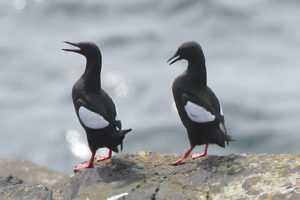 Guillemots is the common name for several species of seabird in the auk family (part of the order Charadriiformes). In British use, the term comprises two genera: Uria and Cepphus. In North America the Uria species are called “murres” and only the Cepphus species are called “guillemots”. This word of French origin apparently derives from a form of the name William, cf. French: Guillaume.Guillemots breed on inaccessible cliffs on rocket coasts and islands with some colonies containing thousands of birds. In winter, most of them go far out to sea, occasionally inshore in bad weather. Guillemots dive for fish from the surface, they also swim well under water using their wings. They often sit upright on the nesting ledges.
Guillemots is the common name for several species of seabird in the auk family (part of the order Charadriiformes). In British use, the term comprises two genera: Uria and Cepphus. In North America the Uria species are called “murres” and only the Cepphus species are called “guillemots”. This word of French origin apparently derives from a form of the name William, cf. French: Guillaume.Guillemots breed on inaccessible cliffs on rocket coasts and islands with some colonies containing thousands of birds. In winter, most of them go far out to sea, occasionally inshore in bad weather. Guillemots dive for fish from the surface, they also swim well under water using their wings. They often sit upright on the nesting ledges.

